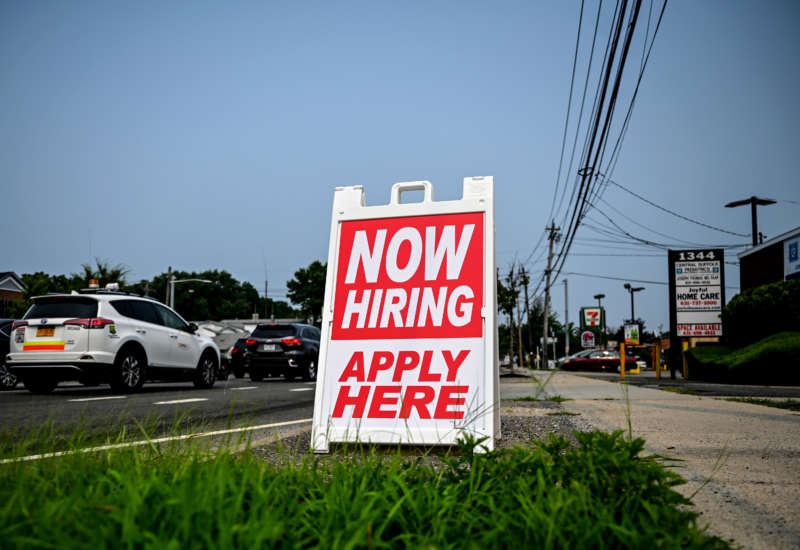The July employment report again showed very strong gains in both the establishment and household survey. In addition to showing 943,000 new jobs in July, the numbers for April and May were also revised up substantially so that the average over the last three months is now 832,000. At that pace, we would make up the jobs lost in the recession in seven months.
Unemployment Record Far Ahead of Recovery From Great Recession
The 0.5 percentage point drop in the household survey was also impressive. We didn’t get down to 5.4 percent unemployment following the Great Recession (GR) until March of 2015. The Black unemployment rate fell 1.0 percentage points to 8.2 percent, a level not reached following the GR until May of 2016. The unemployment rate for Hispanics dropped 0.8 percentage points to 6.6 percent.
Not all the news in the household survey was positive. The unemployment rate for Black teens rose from its record low level of 9.3 percent to 13.3 percent, but this is still lower than any pre-pandemic level.
Unemployment for Asian Americans Above Level for Whites, Reversing Pre-Pandemic Pattern
The unemployment rate for Asian Americans fell from 5.8 to 5.3 percent, but it is still 0.5 percentage points above the rate for whites. It had generally been slightly lower before the pandemic. It’s not clear whether this is the result of discrimination or small businesses owned by Asian Americans continuing to feel the impact of the pandemic.
Share of Unemployment Due to Quits Rises But Still Low
The share of unemployment due to voluntary quits rose 0.9 percentage points to 10.8 percent. However, this is still low; it should be around 14-15 percent in a strong labor market. The share of the unemployed who reported being on temporary layoffs fell to 14.3 percent, which is a normal level. It had been over 70 percent during the shutdowns last spring.
Share of Long-Term Unemployed Still High
The share of long-term unemployed (more than 26 weeks) fell 2.8 percentage points in July, but it is still very high at 39.3 percent. It was only above this level in the recovery following the Great Recession.
Unincorporated Self-Employed Rises in July
The number of people who reported being unincorporated self-employed rose by 425,000 in July, which puts it almost 800,000 above the 2019 average. This could mean many people are starting small businesses as a result of changes in their situation in the pandemic.
Women Accounted for Most of the New Jobs in July
Women accounted for 649,000 of the new payroll jobs in the month. Their share of payroll employment is now 49.9 percent. It had been just over 50.0 percent before the pandemic.
Hardest Hit Sectors Were Big Job Gainers
Local government education added 220,700 jobs, restaurants added 253,200 jobs, hotels added 73,700 jobs, and arts and entertainment added 53,000 jobs. However, employment in all four sectors remains well below its pre-recession level. In percentage terms, the hardest hit sector is motion pictures. It added 17,800 jobs in July, but jobs in the sector are still 30.2 percent below its pre-recession level. Manufacturing and construction both had good gains in the month, adding 27,000 and 11,000 jobs, respectively.
Nursing Homes Continue to Shed Jobs
Nursing homes shed another 1,500 jobs in July, which puts employment 215,600 (13.6 percent) below the pre-pandemic level. This is likely due to the difficulty in finding workers and also reduced demand as the result of many nursing home deaths in the pandemic.
Mixed Evidence on the Labor Shortage Story
The Employment Cost Index (ECI) for the second quarter showed that many of the claims about soaring labor costs were not true. The ECI rose just 0.7 percent in the quarter and is up just 2.9 percent over the last year. However, wages do appear to be rising rapidly at the bottom.
Pay for production and nonsupervisory workers in leisure and hospitality is up 13.0 percent from its year-ago level. It has been rising at an annual rate of 24.3 percent for the last three months (May, June, and July) compared with the prior three months (February, March, April).
The average hourly wage overall is up 4.0 percent for the last year. That is somewhat more rapid than the pre-pandemic clip but can certainly be supported by the rapid productivity growth we have seen in the pandemic. It is important to remember that there was a large shift from wages to profits in the first quarter.
Hours Are Little Changed
There was little change in the length of the average workweek, another piece of evidence for a labor shortage. Average weekly hours for production workers were unchanged in July at 34.2. This is up from 33.7 pre-pandemic, but below the 34.4 peaks in Jan and March. In leisure and hospitality, average hours increased by 0.2 hours to 25.3, the same as the high reached in April.
Very Solid Jobs Report
The job growth figure was again better than most economists had predicted. It appears that the spread of the Delta variant had not had a major impact on the labor market, at least through the middle of July. If its spread can be contained we will likely continue to see strong job growth, coupled with declines in unemployment.


